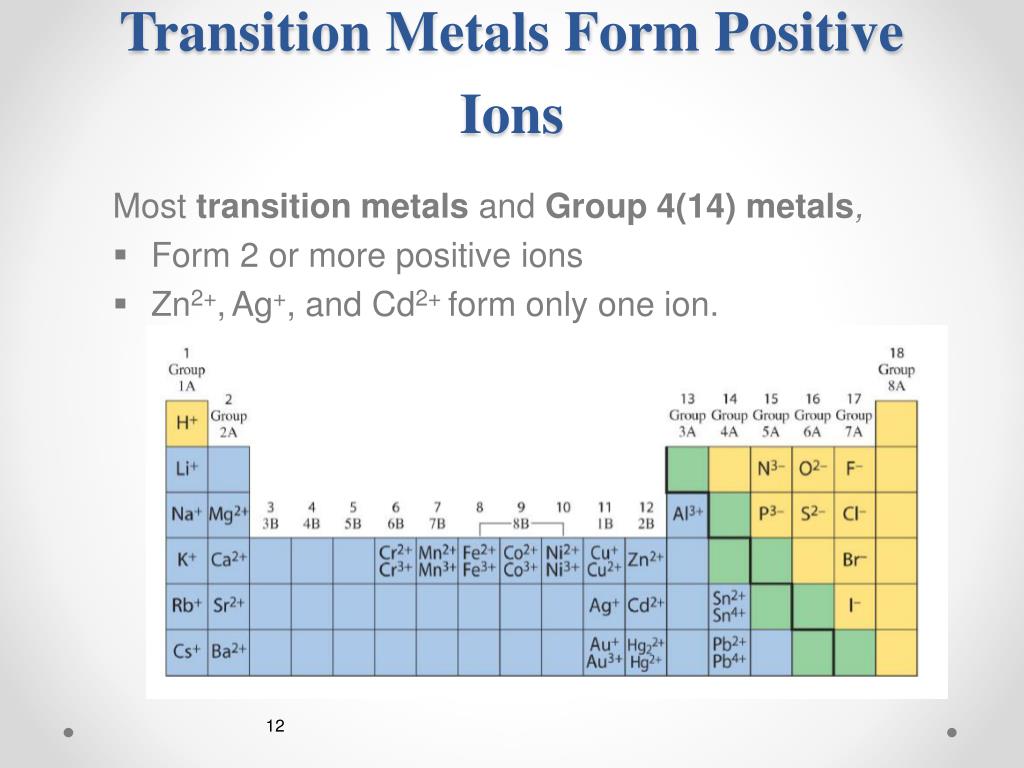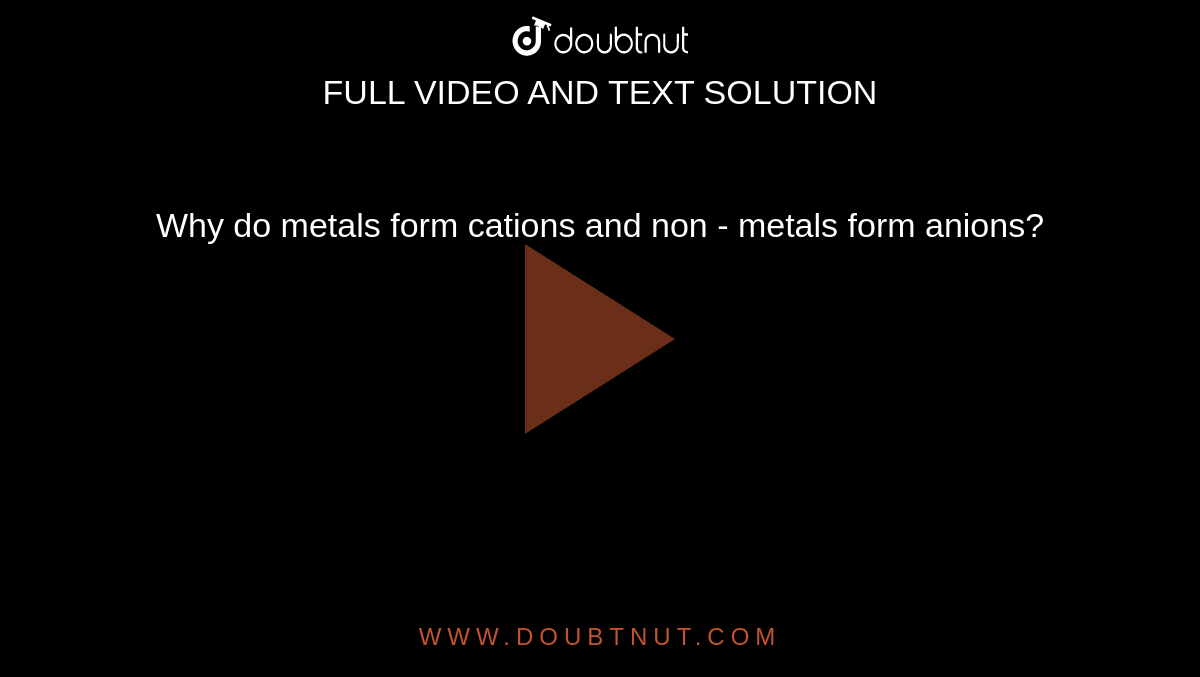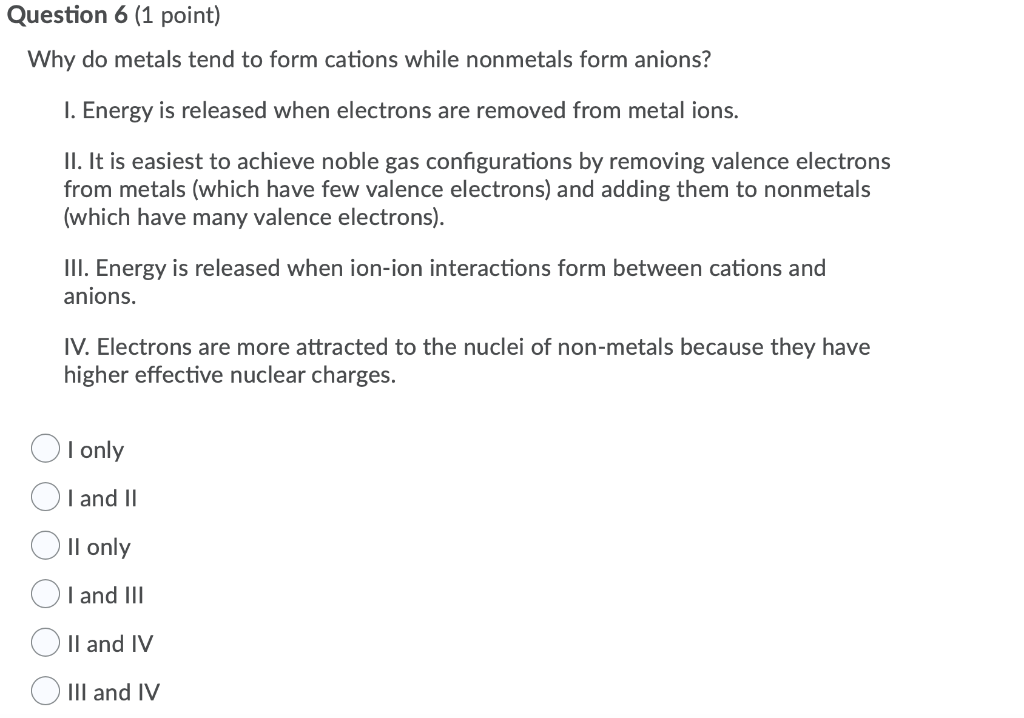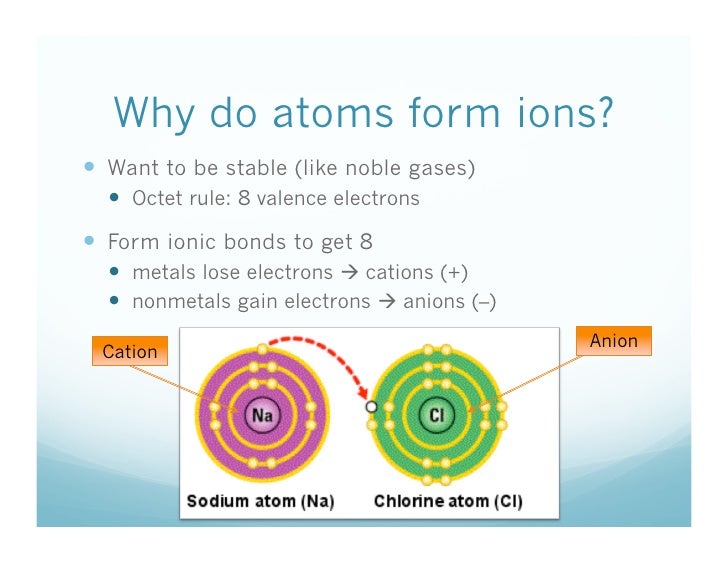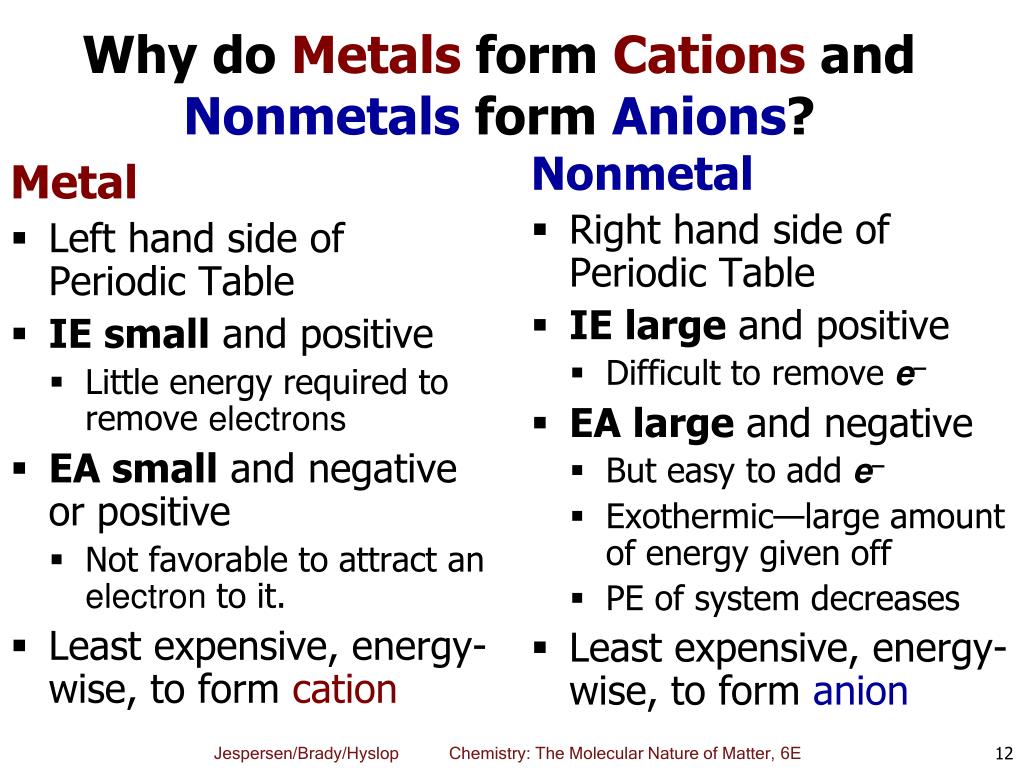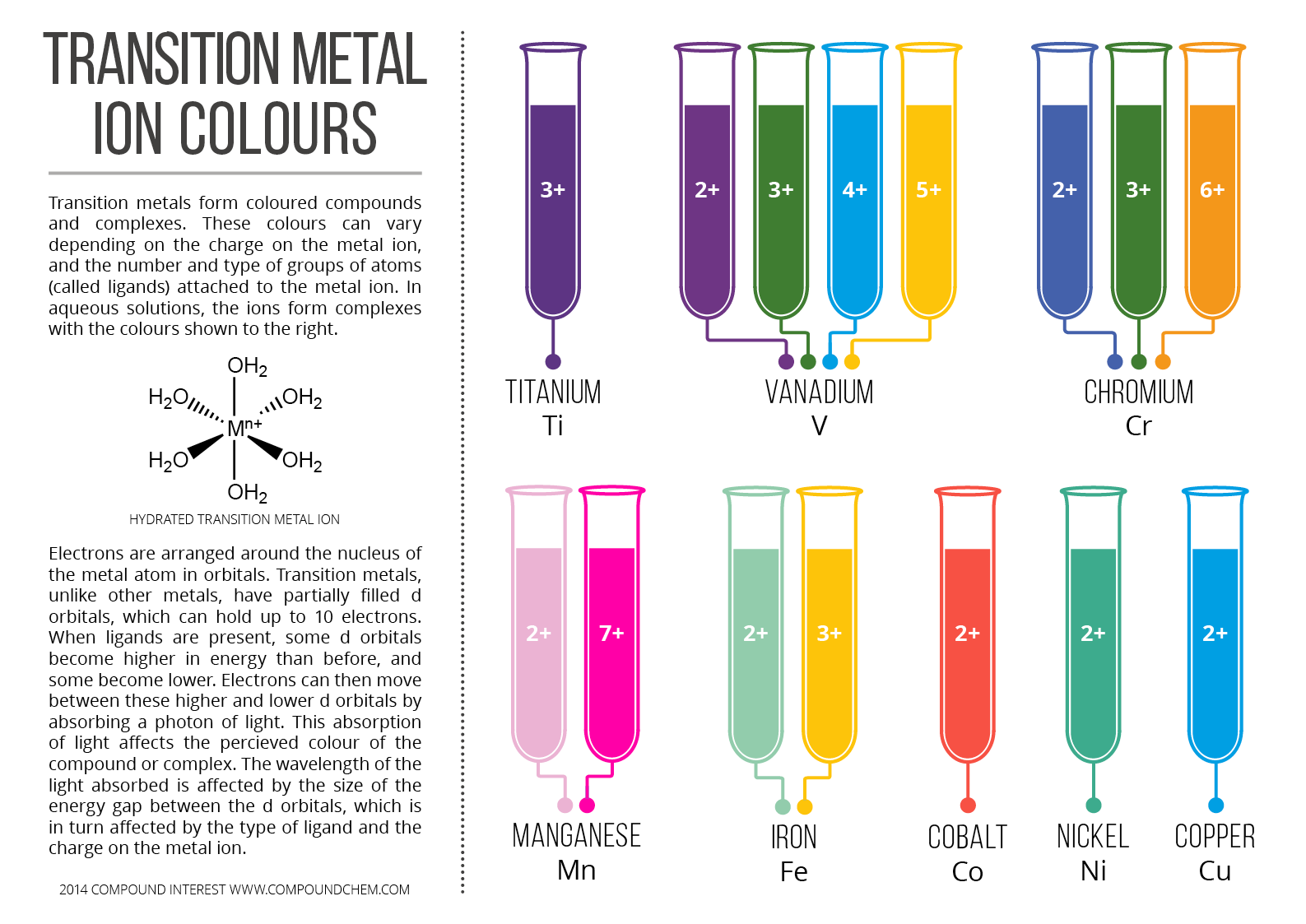Why Do Metals Form Cations
Why Do Metals Form Cations - Metals are good conductors because they have free electrons. The more vigorous its reactions are; Web alkali metals and alkaline earth metals always form cations. Silver and copper are the two best conductors of heat and electricity. Most other nonmetals typically form anions (e.g. Web it is generally known that metals tend to form cations. Web 1 language a metal ion in aqueous solution or aqua ion is a cation, dissolved in water, of chemical formula [m (h 2 o) n] z+. These ions are positive because they contain more protons than electrons. Web metallic atoms hold some of their electrons relatively loosely. Web cations are atoms that contain a positive charge, and they are formed when the atoms lose electrons which are negatively charged.
Web alkali metals and alkaline earth metals always form cations. Cation formation is favored by the relatively low ionization energies of the free metal (which makes it easier to form the. Metals are good conductors because they have free electrons. The more easily it loses electrons in reactions to form positive ions (cations) the table summarises some reactions of metals in the. We will take a closer look at why is that so. These ions are positive because they contain more protons than electrons. Potassium cations are common inside animal cells, and. Consequently, they tend to lose electrons and form cations. Web the alkali metals tend to form +1 cations. Alkali and alkaline earth metals tend to form cations because when losing 1 or.
These ions are positive because they contain more protons than electrons. The more easily it loses electrons in reactions to form positive ions (cations) the table summarises some reactions of metals in the. This is the typical behavior. Web alkali metals and alkaline earth metals always form cations. Web metallic atoms hold some of their electrons relatively loosely. Energy is released when electrons are removed from metal ions. Web 1 language a metal ion in aqueous solution or aqua ion is a cation, dissolved in water, of chemical formula [m (h 2 o) n] z+. Web because of their low positive charge (+1) and relatively large ionic radii, alkali metal cations have only a weak tendency to react with simple lewis bases to form metal complexes. The solvation number, n, determined by a variety of. Metals are good conductors because they have free electrons.
PPT Naming Ionic Compounds PowerPoint Presentation, free download
These ions are positive because they contain more protons than electrons. Energy is released when electrons are removed from metal ions. Metals are good conductors because they have free electrons. Cation formation is favored by the relatively low ionization energies of the free metal (which makes it easier to form the. The more easily it loses electrons in reactions to.
is incorreer? all s area eleseis erand e are metals b, all p area
This is the typical behavior. Web alkali metals and alkaline earth metals always form cations. Web it is generally known that metals tend to form cations. Web atoms lose electrons from their outer shell when they form positive ions, called cations. Web acetylcholine is a cation that is a neurotransmitter, responsible for the transference of nerve impulses.
Chem matters ch6_ionic_bond
Web alkali metals and alkaline earth metals always form cations. Web first, each element that forms cations is a metal, except for one (hydrogen), while each element that forms anions is a nonmetal. The more easily it loses electrons in reactions to form positive ions (cations) the table summarises some reactions of metals in the. Web cations are atoms that.
How To Find Electron Charge On Periodic Table Food Ideas
The more vigorous its reactions are; It is easiest to achieve noble gas configurations by removing valence electrons from metals (which have few. Web metal elements form positively charged ions called cations because they are located on the left side of the periodic table. Most other nonmetals typically form anions (e.g. Energy is released when electrons are removed from metal.
Why do metals form cations and non metals form anions?
Consequently, they tend to lose electrons and form cations. This is actually one of the chemical properties. Web the alkali metals tend to form +1 cations. Web metallic atoms hold some of their electrons relatively loosely. Web first, each element that forms cations is a metal, except for one (hydrogen), while each element that forms anions is a nonmetal.
Do metals form anions or cations quizlet? Book Vea
Web it is generally known that metals tend to form cations. The solvation number, n, determined by a variety of. Consequently, they tend to lose electrons and form cations. Web first, each element that forms cations is a metal, except for one (hydrogen), while each element that forms anions is a nonmetal. Web atoms lose electrons from their outer shell.
Solved Question 6 (1 point) Why do metals tend to form
Web atoms lose electrons from their outer shell when they form positive ions, called cations. The solvation number, n, determined by a variety of. This is actually one of the chemical properties. This is the typical behavior. Web because of their low positive charge (+1) and relatively large ionic radii, alkali metal cations have only a weak tendency to react.
10 28 How Many Electrons Do Atoms Gain Lose
The more easily it loses electrons in reactions to form positive ions (cations) the table summarises some reactions of metals in the. Energy is released when electrons are removed from metal ions. Web alkali metals and alkaline earth metals always form cations. Cation formation is favored by the relatively low ionization energies of the free metal (which makes it easier.
PPT Chapter 9 The Basics of Chemical Bonding PowerPoint Presentation
It is easiest to achieve noble gas configurations by removing valence electrons from metals (which have few. Cation formation is favored by the relatively low ionization energies of the free metal (which makes it easier to form the. Web first, each element that forms cations is a metal, except for one (hydrogen), while each element that forms anions is a.
Colours of Transition Metal Ions in Aqueous Solution [Infographic
Consequently, they tend to lose electrons and form cations. This is the typical behavior. Web it is generally known that metals tend to form cations. Energy is released when electrons are removed from metal ions. Web because of their low positive charge (+1) and relatively large ionic radii, alkali metal cations have only a weak tendency to react with simple.
Web 1 Language A Metal Ion In Aqueous Solution Or Aqua Ion Is A Cation, Dissolved In Water, Of Chemical Formula [M (H 2 O) N] Z+.
Most other nonmetals typically form anions (e.g. Silver and copper are the two best conductors of heat and electricity. The more easily it loses electrons in reactions to form positive ions (cations) the table summarises some reactions of metals in the. We will take a closer look at why is that so.
The More Vigorous Its Reactions Are;
Web acetylcholine is a cation that is a neurotransmitter, responsible for the transference of nerve impulses. This is the typical behavior. Web metallic atoms hold some of their electrons relatively loosely. Web atoms lose electrons from their outer shell when they form positive ions, called cations.
Web Because Of Their Low Positive Charge (+1) And Relatively Large Ionic Radii, Alkali Metal Cations Have Only A Weak Tendency To React With Simple Lewis Bases To Form Metal Complexes.
Web it is generally known that metals tend to form cations. Cation formation is favored by the relatively low ionization energies of the free metal (which makes it easier to form the. Potassium cations are common inside animal cells, and. The solvation number, n, determined by a variety of.
This Is Actually One Of The Chemical Properties.
Energy is released when electrons are removed from metal ions. Consequently, they tend to lose electrons and form cations. Web alkali metals and alkaline earth metals always form cations. Web metal elements form positively charged ions called cations because they are located on the left side of the periodic table.
